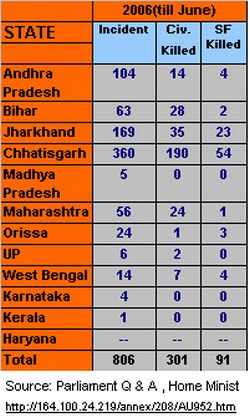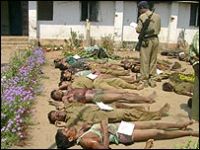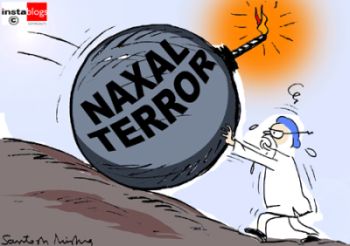
Naxal attack on Rani Bodli police outpost in Bijapur was the biggest strikes in recent times in Chhattisgarh since the state was formed on November 1, 2000. More than 400 rebels were said to attack on the outpost around 2 am midnight and carried the strike till 5 in the morning. They surrounded the outpost, lobbed grenades and petrol bombs, opened discriminate firing and then set the camp blazed. They fled with 50 weapons including AK-47s and SLRs from the outpost and before fleeing they had land-mined the area.
More than 50 security personnel were killed in the brutal attack. It caused an embarrassing situation for the state government and the doubt has been raised on the government’s policy of luring locals in the fight against naxal extremism.

The term Naxalites comes from Naxalbari that is a small village in West Bengal. In this village, Communist Party of India (Marxist) leaders Charu Majumdar and Kanu Sanyal had tried to develop a revolutionary opposition against the CPI (M) leadership in the state. On May 25, 1967, the revolt started in Naxalbari when some local authorities attacked a tribal over a land issue. Then, the tribals attacked the landlords and the violence escalated.
Since then, the Naxal insurgents have been influenced from 76 districts in nine states to 118 Districts in 12 States. On September 21, 2004, the CPI (Maoists) was formed after the merger of two major naxal outfits such as the CPI (Marxist-Leninist) People’s War (PWG) and the Maoist Communists Center of India (MCCI).

Now, it has created a ‘Red Corridor’ from Andhra Pradesh, through eastern Maharashtra, Madhya Pradesh, eastern Uttar Pradesh, Chhattisgarh, Jharkhand, to West Bengal and Bihar. The report says that the ‘Red Corridor’ unites the left-extremists of India with their comrades in Nepal too.
The so-called Red Corridor covers 155 districts in India that is almost 25% of national territory. Further, the rapid growing of its expansion clearly betrays the fact that the security agencies as well as the political leadership, at both the center and states, are fighting with the Naxalites with full force. The security agencies and state governments are clueless and lack enough force and will power to tackle India’s greatest enemy within.
The government has not come out with a foolproof plan even after the Research and Analysis Wing (RAW) has been warned the central government that many Naxalites have tried to coordinate with some international terrorist groups those are working against political and social stability in India, such as the LTTE and ISI. The report further says naxals are also engaged in weapons transactions with those organizations.
According to the intelligence report, the ISI is using naxal network in India for drug trafficking and pumping fake currency notes in Indian market. In return, naxalites are getting the sophisticated weaponry and the process to make and use spontaneous explosive devices.
Currently, India is facing a situation that may be defined as a serious threat to the stability and internal security. Former DGP of Punjab K P S Gill once had said that it does not make sense to build roads and bridges, which cannot be used for fear of death at the hands of Naxalites.

The biggest question is that what are the steps taken by the government till now against the rising problem of naxal insurgency. On 19 September 2005, the government had organized the first meeting of the Standing Committee of Chief Ministers of the Naxalite affected States of India in New Delhi. Home Minister Shivraj Patil had chaired the meeting. During the meeting, the central government and the states decided to make the Inter-State Joint Task Forces functional very quickly to facilitate coordinated anti-Naxalite operations.
As the first step, the States decided to appoint nodal officers for coordination with each other as well as with the Centre. The Home minister had concluded by saying that the problem of Naxalism has to be addressed by ensuring effective and sustained police action against the Naxal violence and, at the same time, accelerating socio-economic development of the affected areas too.
Despite its speechifying on socio-economic development of the problematic regions, the Central government and the State governments, most of the times, opted to go with militaristic approach to counter the Naxalite problems. This is the root problem.
Naxals are not terrorists but being used by the terrorist-minded people. The political leaders always kept these tribals away from the development of states and country. Now, the naxals look towards development as their biggest enemy.
Just look at the total annual expenditure from the Centre and States on the modernisation of police for anti-Naxalite operations. This touches Rs. 2,000 crores mark. And just look towards the contrast of the story, the central government has recently decided to allocate meager Rs. 2 crores per year to per Naxal-affected district to develop the socio-economic situation.
The cost of devastation is more than the cost of the construction. This is the basic problem with our national leadership.

On the other hand, despite of spending more on the modernization of police forces the situation is exactly the same as it was years before. Ajai Sahni, head of New Delhi’s Institute for Conflict Management, has said that under-equipped and poorly armed security forces have not been able to tackle the growing naxal threat in India.
He said:
Raising the strength, capacities and presence of the police force in Naxal affected areas is important step than anything else. You cannot have these little pockets of police camps with nothing in terms of administration, nothing in terms of successive barriers of security, and expect them to protect anybody, they cannot even protect themselves.
The people who died in Bijapur police outpost were not lazy policemen who were sleeping; they were the policemen who were unable to protect themselves.
The government’s call for taking steps for socio-economic development of the Naxalite affected areas is praiseworthy but the biggest problem is to understand that would the economic development be enough for areas where people have no any basic infrastructure.
Naxalism is growing in the undeveloped areas because of extreme poverty, unemployment and the collapse of the state structure. Government has failed to provide the access of basic human needs to the poor people living in those areas. Further, the atrocities by security forces and forest officials are adding fuel to the fire.
Land reforms are very important to tackle the Naxalite problems but the government has never thought to put this in her strategy. It seems, the government is treating Naxalism as mere law and order problem. This is more a social and political problem than a law and order problem. Unless the government takes rights based approach towards the poor people in the undeveloped region, Naxalism will continue to survive.
Source: [1], [2], [3], [4]
Image Source: BBC



